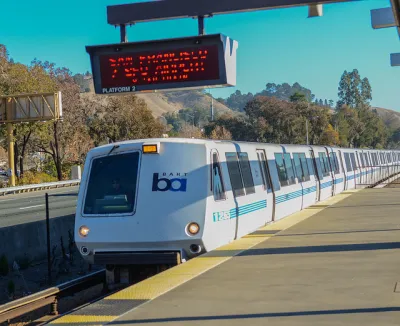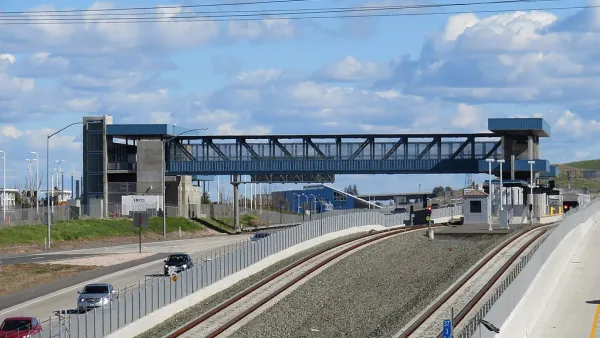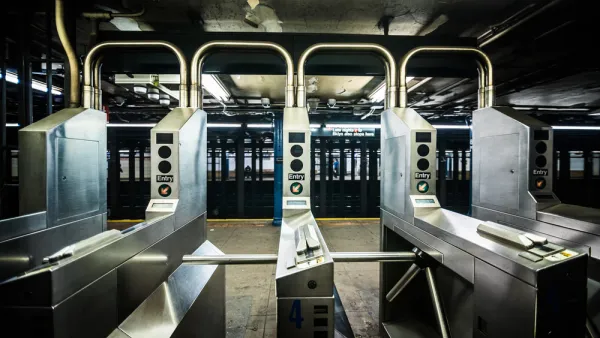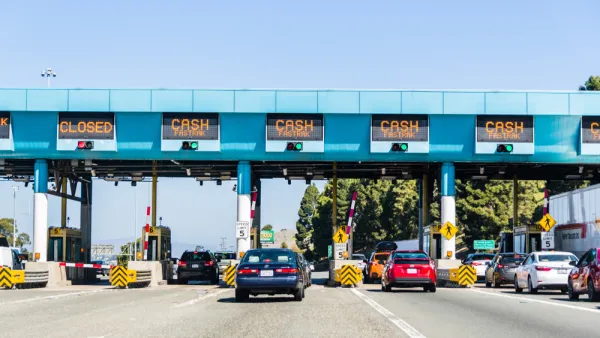The gas tax bill couldn't pass soon enough for the Bay Area's metro system. Service cuts and fare increases, scheduled for approval April 13, were greatly reduced due to an unexpected $16 million BART will receive, and the bill has yet to be signed!

"BART officials were set Thursday [April 13] to fill a looming multimillion-dollar budget gap in ways that would hurt many of its passengers," reports Michael Cabanatuan for the San Francisco Chronicle.
They would start trains an hour later in the morning, eliminate after-hours bus service and slash discounts for seniors, kids and riders with disabilities.
The service cuts and fare increases for the three above groups, scheduled to take effect January 1, 2018, resulted from "a projected $31 million deficit (that) BART blames on declining ridership — mostly on weekends — and a drop in sales tax revenue," adds Cabanatuan. In addition, the the new Warm Springs/South Fremont BART Station is also expected to add to the operating deficit (more on that below).
Unfortunately for BART riders, the across-the-board 2.7 percent fare increase, also scheduled for January 1, is unaffected by the bill's passage.
The partial relief, described below, was made possible on April 6 when 27 state senators, the bare minimum needed for a two-thirds supermajority, passed the extensive road and transit funding package, and then, even more remarkably, the Assembly followed suit, also with the minimum 54 votes to constitute a two-thirds supermajority [See both votes here].
As a result, "Sacramento would deliver an extra $16 million this year — enough to allow BART to pare its proposed budget cuts nearly in half," reports Cabanatuan.
That sent staff back to their spreadsheets. Seniors, people with disabilities, early risers and late workers or partyers would be spared from the budget cuts, but youths would have to pay higher fares, as would riders who continue to rely on BART’s familiar paper tickets with the magnetic stripe rather than switch to Clipper cards.
According to the governor's office, local public transit will receive $7.5 billion (14.3 percent) of the projected $52.4 billion over the next decade from the Road Repair and Accountability Act of 2017, and $1 billion (2 percent) will go to improve infrastructure that promotes walking and bicycling.
Extensions don't cover their operating costs
While BART’s declining ridership and sales tax revenue may contribute to the deficit, so do the opening of new extensions, said Nick Josefowitz, a BART director from San Francisco. Josefowitz said the opening of extensions to Warm Springs/South Fremont last month and, in spring 2018, of a diesel-rail line [eBART] in eastern Contra Costa County, are also driving the deficit.
Revenue from new passengers won’t cover the cost of staffing the new stations and trains, he said. He was unable to immediately provide dollar figures
Readers may recall that last November, voters in the three BART counties of San Francisco, Alameda and Contra Costa counties passed Measure RR, a $3.5 billion infrastructure bond measure, with 70.50 percent of the vote, well above the required two-thirds threshold. However, those bond revenues will go toward capital, not operational expenses.
A few final words on the significance of the Road Repair and Accountability Act of 2017. The last time the state legislature passed a gas tax increase was 1989 [see page 43 (pdf), almost 28 years ago, and that nine cents per gallon increase, without an inflation adjustment, was sent to the voters for approval in 1990. In addition, due to constitutional restrictions, most of the tax revenue went toward roads.
Lastly, the Road Repair and Accountability Act, unlike the 1989 legislation, increases the diesel excise tax by 20 cents per gallon, the diesel sales surtax by four percent, and adds a new vehicle licensing fee and zero emission vehicle fee. Gas and diesel taxes will increase on Nov. 1.
FULL STORY: BART spared tough budget decisions by last-minute state help

Analysis: Cybertruck Fatality Rate Far Exceeds That of Ford Pinto
The Tesla Cybertruck was recalled seven times last year.

National Parks Layoffs Will Cause Communities to Lose Billions
Thousands of essential park workers were laid off this week, just before the busy spring break season.

Retro-silient?: America’s First “Eco-burb,” The Woodlands Turns 50
A master-planned community north of Houston offers lessons on green infrastructure and resilient design, but falls short of its founder’s lofty affordability and walkability goals.

Test News Post 1
This is a summary

Analysis: Cybertruck Fatality Rate Far Exceeds That of Ford Pinto
The Tesla Cybertruck was recalled seven times last year.

Test News Headline 46
Test for the image on the front page.
Urban Design for Planners 1: Software Tools
This six-course series explores essential urban design concepts using open source software and equips planners with the tools they need to participate fully in the urban design process.
Planning for Universal Design
Learn the tools for implementing Universal Design in planning regulations.
EMC Planning Group, Inc.
Planetizen
Planetizen
Mpact (formerly Rail~Volution)
Great Falls Development Authority, Inc.
HUDs Office of Policy Development and Research
NYU Wagner Graduate School of Public Service




























